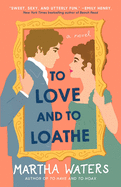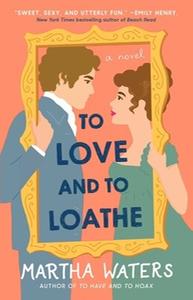
 Following To Have and to Hoax, Martha Waters's To Love and to Loathe returns to Regency-era England with a witty enemies-to-lovers romance that sparkles with banter and tension. Young widow Diana, Lady Templeton, is looking for an affair but doesn't have the reputation to let eligible gentlemen know she might be interested. Her brother's longtime friend Jeremy, Marquess of Willingham, is known in society for his many liaisons. Isn't it convenient that they're both available at the same time, that he's holding a two-week house party and that they've been carrying a torch for each other for years?
Following To Have and to Hoax, Martha Waters's To Love and to Loathe returns to Regency-era England with a witty enemies-to-lovers romance that sparkles with banter and tension. Young widow Diana, Lady Templeton, is looking for an affair but doesn't have the reputation to let eligible gentlemen know she might be interested. Her brother's longtime friend Jeremy, Marquess of Willingham, is known in society for his many liaisons. Isn't it convenient that they're both available at the same time, that he's holding a two-week house party and that they've been carrying a torch for each other for years?
The plot is a bit more complicated, however. Diana bets Jeremy that he'll be married within a year and enlists the help of his grandmother in her matchmaking scheme. So even as she's attempting to set him up with an eligible young woman during the house party, Diana negotiates a short-term fling with Jeremy--a practical arrangement that of course won't involve their hearts at all. "His intention had been to remind her of the strange, potent connection between them, to leave her wanting more. He had no idea... if he'd accomplished that aim--but he'd undoubtedly succeeded at reminding himself."
To Love and to Loathe is told in alternating points of view, illustrating two similarly delusional perspectives. Both express their attraction through good-natured bickering as funny as it is obvious (to everyone but them). " 'I'm surprised you weren't cozying up to Lady Helen...' Willingham said, giving her a dazzling smile. It was one she had seen him use on numerous ladies, with universal success. She gave him a severe look. His smile widened."
Waters employs several classic romance tropes, including a bet, a meddling grandmother and two characters convinced they can have a fling to get years of attraction out of their systems. After all, they're both too intelligent and worldly to develop any pesky feelings for one another.
The Happily Ever After guaranteed by a romance novel puts readers in the position to revel in the antics of two characters while knowing they'll never succeed in denying their feelings as they're so determined to do. It's this experience--a shared knowing with the author--that makes To Love and to Loathe so enjoyable. While Diana and Jeremy attempt to lie to themselves and each other, readers know the delicious truth: that they've been meant for each other since the day they met. --Suzanne Krohn, editor, Love in Panels
Shelf Talker: Martha Waters's second historical romance is a delightful enemies-to-lovers escape filled with banter and humor--perfect for readers looking to laugh and swoon in equal measure.

